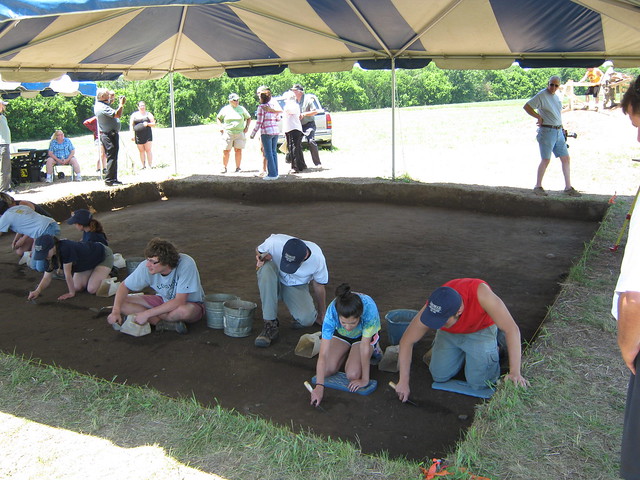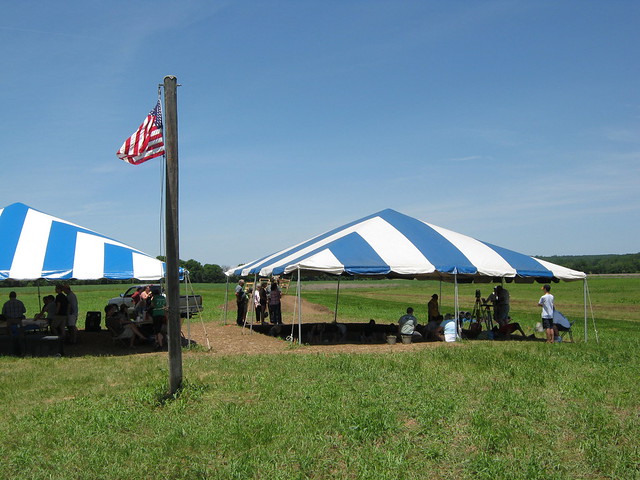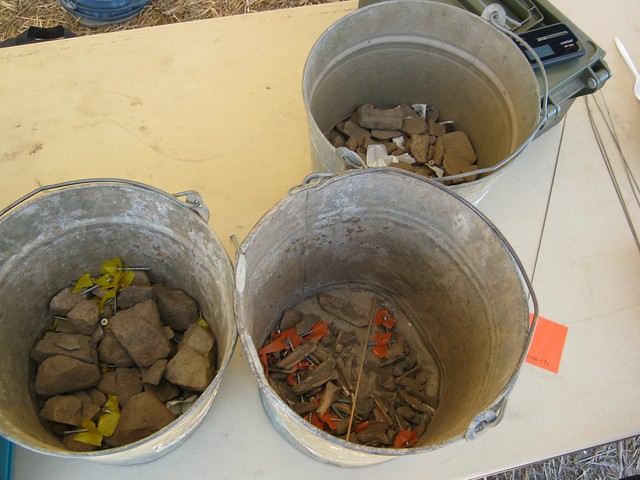Open fires are prohibited throughout the park from midnight to 4 p.m. through April 30 per the 4 p.m. Burning Law. This includes wood and charcoal. Gas is permissible. Campground fires are allowed during the restricted time if a camp host is on duty and signage to that effect is posted in the campground. Failure to observe the 4 p.m. Burning Law can result in a fine. Contact the Park Office for additional information.
Read Our Blogs
Digging for Discovery
Shared by Evin Morrison, Marketing Intern, as Guest Blogger.
Staunton River Battlefield State Park is a location full of beauty and history. An ongoing archaeological dig in the park has been revealing artifacts and information on Native Americans. Aside from the Civil War background, the park offers insight to the Native Americans that lived in the area over 1,000 years ago.

Students from the Longwood University Archaeology Field School are shown digging for artifacts at Staunton River Battlefield.

Tents provide a bit of shade for the students participating in the research project
The Staunton River Battlefield Project is a partnership between Dr. James W. Jordan Archaeology Field School of Longwood University and the Virginia Department of Conservation - Division of State Parks. The project was originally focused on finding artifacts from the famous Civil War battle that occurred at the location. However, when digging began something entirely different was found: an ancient Native American village. The village was over 1,000-years-old and was once home to the Sappony Indian tribe. Students return to the site for field research each year during May and June.
Data shows that the area was occupied year-round from 950 A.D. to 1425. Around 200 people inhabited the area at a given time. The site and its artifacts have helped scholars gain information about the daily life along the banks of the Staunton River more than 1,000 years ago. Over the years 100,000 artifacts have been found. These artifacts include pottery, tools, and even bodies from the Native American tribe. There have also been many shells found from the river, which was once closer to the dig site area than it is today. Some of these artifacts are displayed in the Roanoke Visitor Center at the park. Overall, the research involved with the site focuses on gaining knowledge about Native American farming, burial, and social practices.
The site at Staunton River Battlefield State Park offers an outdoor laboratory for the archaeological students of Longwood University. Students use the site to gain hands on experience in the archaeological field. Recently, they have found many items of interest such as: bones, shells, beaver’s teeth, tools, pottery and arrowheads.

Items found during the dig are sorted into categories
The process of discovering these artifacts starts when an area is marked off and flattened. Then, the students softly scrape on the soil with tools and the soil is sifted, leaving behind any potential objects of value. The items found are usually placed in one of three different buckets: lithics, ceramics, and organics. Organics include anything that once belonged to a living creature such as bones, teeth, and shells. Ceramics include pottery and the stone tools and weapons are placed in the lithics container. Once the dig is complete, the area is covered and the students move to a different location.
The dig at Staunton River Battlefield State Park offers a glimpse into the past and is a terrific learning experience for aspiring archaeologists and visitors to the park. Its not often a Native American village has been unearthed on a Civil War Battlefield and the results are exciting to observe.
Dr. Brian Bates, Professor of Anthropology at Longwood University, is Director of the Archaeology Field School. On Saturday, September 6, 2014, Dr. Bates will be the featured speaker for the annual meeting of the Historic Staunton River Foundation. Dr. Bates will talk about his findings from the Staunton River Project over the years. The covered dish dinner and meeting will begin at 6:00 p.m. at the park's Roanoke Station Visitor Center in Randolph, VA. For more information about the Historic Staunton River Foundation click here or email info@historicstauntonriverfoundation.org.
LOCATION:
Staunton River Battlefield Sate Park is located in Halifax and Charlotte Counties. For Visitor Center hours, or for more information, call 434-454-4312 or send an email.
If you have read the article and have a question, please email nancy.heltman@dcr.virginia.gov.
Search for blogs
By Park
Categories
Cabins
Camping
Fishing
History and Culture
Other
Programs and Events
Trails
Volunteers
Water Fun
Archive
2024
2023
2022
2021
2020
2019
2018
2017
2016
2015
2014
2012














